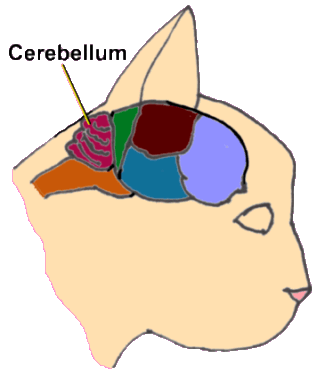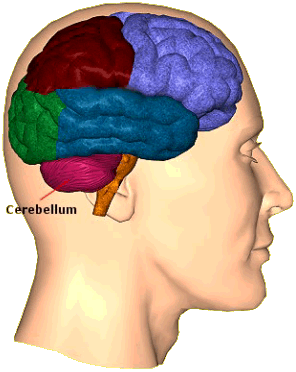Distemper (Panleukopenia) in Cats
Feline distemper, also known as feline panleukopenia, is a very contagious, life-threatening infectious disease of cats. It commonly swoops through a group of cats, especially kittens, leaving a trail of death behind it. Fortunately, vaccination is highly effective and the “feline distemper vaccine” (which also covers upper respiratory infectious agents) is considered to be the core immunization for all cats, regardless of their lifestyle. Most people have heard of feline distemper only through discussion of routine cat vaccinations, but let’s talk about the actual disease.

The Virus Itself
The feline distemper virus amounts to a single strand of DNA surrounded by a protein coating. It is extremely stable in the environment, which leads to its characterization as ubiquitous (everywhere). It can last a year indoors at room temperature. It survives freezing as well as treatment with such common disinfectants as alcohol and iodine. Fortunately, soaking a surface in bleach (diluted 1 part bleach in 32 parts water) for 10 minutes will kill it.
Virtually every cat in the world will be exposed to this virus to some extent because the virus lives all around us.
Infection occurs when the virus enters the body through the mouth or nose. Whether illness results or not depends on the immunity in the victim vs. the number of individual virus particles (i.e. the amount of virus) entering the body.
The feline distemper virus is a parvovirus. Many people are familiar with this term as parvovirus infection is a very real concern for dogs, especially puppies. In fact, canine parvovirus is closely related to the feline distemper virus and much of the information regarding canine parvovirus holds true for feline distemper. The feline distemper virus, however, is more difficult to remove from the environment and more lethal in its victims than its canine counterpart.
Infection and Disease
An infected cat sheds large amounts of virus in all body secretions, including feces, vomit, urine, saliva, and mucus. The virus persists long after evidence of the original body secretion has faded away. The virus enters the victim’s body and proceeds to seek and infect rapidly dividing cells. The lymph nodes in the throat are first to be affected and from there, over the next two to seven days, the virus rushes to the bone marrow and intestine.
In the bone marrow, the virus suppresses the production of the entire white blood cell line, hence the term panleukopenia (literally, “all-white-shortage”). White blood cells are the immune cells needed to fight the infection, and without them, the victim is completely vulnerable to the advance of the virus. In other words, the first order of the virus’s business is to eliminate its host’s defenses. From there, it continues to the intestinal tract.
There, the virus infects the intestinal cells, causing ulceration leading to diarrhea and life-threatening dehydration as well as bacterial infection as the barrier between the body and intestinal bacteria is lost. The patient dies from either dehydration or secondary bacterial infection. The infection can be so rapidly overwhelming that death occurs before the vomiting and diarrhea even begin.
Because most cats are exposed to this virus to some extent, it is unusual for a kitten to have no immunity whatsoever. Furthermore, the vaccine is so effective that even one dose can provide long-lasting protection. As a result, infection is largely limited to unvaccinated younger animals kept in groups such as a colony of barn cats, feral cats, or even a group of shelter cats. Viral numbers (the amount of virus) must be large enough to overwhelm a cat’s partial immunity, but once virus-laden diarrhea begins to gather in the environment, those large numbers can be reached. Death of sick cats is typically considered to be 90%, though it has been said that a kitten who survives the first 5 days is likely to survive the infection.
Recovered kittens are considered contagious for six weeks following recovery.
Cerebellar Hypoplasia
A specific syndrome occurs if infection occurs during pregnancy. If infection occurs in mid or early pregnancy, the kittens simply abort. If the kittens are fairly far along, the cerebellum is involved, leading to cerebellar hypoplasia. The cerebellum is the part of the central nervous system that coordinates balance and movement, enabling one to walk or run on an uneven surface without consciously thinking about it.

Without a normal cerebellum, the kitten is born with marked intentional tremors: whenever he focuses on purposeful movement, he tremors so much that normal movement is impossible. Such kittens are called wobbly cats and are notably abnormal but are considered to have good life quality and can be kept as pets as long as they are looked after.
Diagnosis of Infection
Any kitten with fever, appetite loss, diarrhea, and/or vomiting is a suspect for feline distemper. Classically, a white blood cell count shows almost no white blood cells; there are few causes of white cell counts this low and the infection can be considered confirmed.
The SNAP Fecal ELISA test kit made for canine parvovirus is often used in cats as a means to reach a distemper diagnosis. This test detects parvovirus in stool and is felt to be accurate although the test is not specifically labeled for this use by the manufacturer. Vaccination 5-12 days prior to running the test can lead to a false positive test as the virus from the vaccine will be detected. It is important to keep this information in mind when using this test to make a diagnosis; recent vaccination will cause a false positive.

If a dead kitten is available for necropsy (that’s an autopsy in animals), the infection is readily confirmed by laboratory tissue analysis as there are unique tissue findings in feline distemper.
Virus isolation, PCR testing, and antibody level measurement are also potential tests for feline distemper.
Treatment
An infected cat can recover if the cat can be kept alive until the immune system recovers from the panleukopenia and can throw off the infection. This means that invading intestinal bacteria must be kept at bay with antibiotics and aggressive fluid therapy must control dehydration. Hospitalization is required as fluids and medications must be given intravenously. Blood sugar must be supported as well and control of pain, nausea, and hypothermia is crucial. This is essentially the same therapy as for canine parvovirus infection, though the feline experience seems to be more lethal. There is little chance of survival without hospitalization.
Recovery
If a cat is lucky enough to recover from this infection, generally, no permanent damage is retained, and the cat goes on with lifetime immunity.
- Virus is shed for up to six weeks after recovery.
Disinfecting the environment after infection is a huge challenge; the best protection for newly introduced cats will be vaccination. That said, bleach diluted 1:32 in water with a 10-minute contact time will kill the distemper virus, so it would be prudent to bleach any surfaces that can be bleached.
Prevention
Vaccination after age 12 weeks is generally effective in generating immunity against this infection, though immunity gained from mother’s milk may inactivate the vaccine through age 14 to 16 weeks. Most vaccine protocols call for at least two doses of vaccine to be given 2-4 weeks apart with the last dose being received at or after age 14 weeks. There are some vaccines that are approved for single-dose effectiveness depending on the age of the kitten.
- Vaccination, at least with a live vaccine, should be avoided during pregnancy as cerebellar hypoplasia (see above) can result in the kittens.
Vaccination is generally given every one to three years depending on the protocol of the animal hospital. Vaccination can be given as an injection (either modified live or killed virus vaccine) in the right front leg area or can be presented as a nose drop.
Killed virus vaccine has been associated with vaccination-associated fibrosarcoma (an aggressive cancer) in rare individuals. Research is continuing in this area; however, the killed virus vaccine has largely been replaced by a modified live virus vaccine, which is not felt to have this problem.



